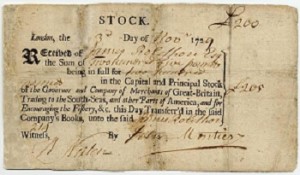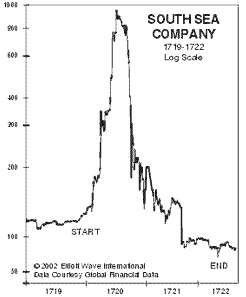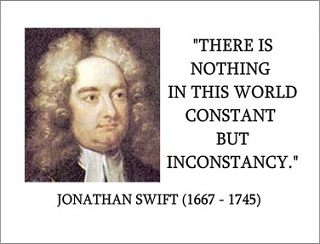By Jesse Colombo (This article was written on June 5th, 2012)
Sometimes called the “Enron of England,” the South Sea Bubble was one of history’s worst financial bubbles.
 The South Sea Bubble’s story started in 1711, after a war with Spain left Britain 10 million pounds in debt. The British government proposed a deal to a financial institution, the South Sea Company, in which Britain’s debt would be financed in return for 6% interest. The government offered the company another benefit to sweeten the deal: exclusive trading rights with Spain’s colonies in the South Seas, now known as South America. The South Sea Company quickly agreed to the deal due to the potentially lucrative trading opportunities with the gold and silver-rich South American colonies. Additionally, it was believed that Mexicans and South Americans would eagerly trade their gold and jewels for the wool and fleece clothing of the British. The company also planned to establish a monopoly in the slave trade.
The South Sea Bubble’s story started in 1711, after a war with Spain left Britain 10 million pounds in debt. The British government proposed a deal to a financial institution, the South Sea Company, in which Britain’s debt would be financed in return for 6% interest. The government offered the company another benefit to sweeten the deal: exclusive trading rights with Spain’s colonies in the South Seas, now known as South America. The South Sea Company quickly agreed to the deal due to the potentially lucrative trading opportunities with the gold and silver-rich South American colonies. Additionally, it was believed that Mexicans and South Americans would eagerly trade their gold and jewels for the wool and fleece clothing of the British. The company also planned to establish a monopoly in the slave trade.

The South Sea Company issued stock to investors to help finance its operations. Investors quickly snapped up the company’s shares to profit from their trading monopoly with Spain’s South Seas colonies. After the resounding success of their first share issue, the company issued even more shares. This stock was aggressively accumulated by investors even though the company was led by an inexperienced management team. Results were the only thing that mattered to South Sea Company investors and the company’s stock was soaring. Many investors were impressed with the South Sea Company’s lavish corporate offices, which projected an image of success and wealth. During this time, it was extremely fashionable to own South Sea Company shares.
The South Sea Company’s management team started to hype their stock, creating illusions of grandeur in the minds of investors. Speculation became rampant as share prices soared. It was thought that this company “could never fail.” Eventually, South Sea Company’s management team developed rumors that the South Sea Company had been granted full use of Latin American ports by Spain. The truth, however, was that Spain only allowed three ships per year. Unrealistic expectations were the norm among South Sea’s investors and speculators.
 Much like Enron, corruption was widespread among directors, company officials and their political friends. Scores of new IPOs were floated as other companies tried to profit from Britain’s stock boom as well. These companies claimed to be involved in dubious businesses such as building floating mansions and distilling sunshine from vegetables. Regardless of their story, these shares were snatched up by speculators along with South Sea Company shares. Many investors became fabulously wealthy almost overnight as their shares soared. Even Sir Isaac Newton had invested in South Sea Company shares, though he sold his shares fairly early on in the bubble for a 7,000 pound profit due to his worries of a coming stock market crash. As the South Sea Bubble continued to inflate, Newton changed his mind and bought more shares.
Much like Enron, corruption was widespread among directors, company officials and their political friends. Scores of new IPOs were floated as other companies tried to profit from Britain’s stock boom as well. These companies claimed to be involved in dubious businesses such as building floating mansions and distilling sunshine from vegetables. Regardless of their story, these shares were snatched up by speculators along with South Sea Company shares. Many investors became fabulously wealthy almost overnight as their shares soared. Even Sir Isaac Newton had invested in South Sea Company shares, though he sold his shares fairly early on in the bubble for a 7,000 pound profit due to his worries of a coming stock market crash. As the South Sea Bubble continued to inflate, Newton changed his mind and bought more shares.
How the South Sea Bubble Popped
In 1718, Britain and Spain went to war again, stopping all chances for trade. Investors were not daunted and kept buying stocks. Investors from other European countries started to take part in the South Sea Bubble as well. At this point, the South Sea Company’s leaders realized that their company wasn’t generating much profit from its operations so they decided to place more emphasis on generating revenues from the issuance of stock and speculative endeavors instead actual commerce. The company’s new business philosophy led to situations such as large shipments of wool being left to decay as a result of careless shipping mistakes. Around this time, management realized that their company’s shares were incredibly overvalued relative to its profits and decided to sell their shares while other investors were still unaware that the company was barely profitable.
 Eventually, word broke among investors that the South Sea Company’s management team had sold all of their shares in the company, leaving investors holding the bag. Panic selling immediately ensued as investors dumped the South Sea Company and soon other companies’ near-worthless shares. Fortunes were lost in a heartbeat. Isaac Newton lost over 20,000 pounds of his fortune. As a result of this crisis, he stated “I can calculate the motion of heavenly bodies, but not the madness of people” (see graphic above). Jonathan Swift, who also lost a fortune, was inspired to write Gulliver’s Travels, a satire about British society. Fortunately, the Bank of England helped to avert a banking crisis as it acted as a “lender of last resort.” The issuing of shares was outlawed to prevent future bubbles. Despite the government’s efforts, Britain’s economy was in shambles after the South Sea Bubble popped and didn’t fully recover until nearly a century later. Several generations were adversely affected by the popping of the South Sea Bubble.
Eventually, word broke among investors that the South Sea Company’s management team had sold all of their shares in the company, leaving investors holding the bag. Panic selling immediately ensued as investors dumped the South Sea Company and soon other companies’ near-worthless shares. Fortunes were lost in a heartbeat. Isaac Newton lost over 20,000 pounds of his fortune. As a result of this crisis, he stated “I can calculate the motion of heavenly bodies, but not the madness of people” (see graphic above). Jonathan Swift, who also lost a fortune, was inspired to write Gulliver’s Travels, a satire about British society. Fortunately, the Bank of England helped to avert a banking crisis as it acted as a “lender of last resort.” The issuing of shares was outlawed to prevent future bubbles. Despite the government’s efforts, Britain’s economy was in shambles after the South Sea Bubble popped and didn’t fully recover until nearly a century later. Several generations were adversely affected by the popping of the South Sea Bubble.
Other South Sea Bubble Resources:
History House: The South Sea Bubble
Market Crashes: The South Sea Bubble
The South Sea Bubble (TheSouthSeaBubble.com)
Memoirs of Extraordinary Popular Delusions and the Madness of Crowds: The South-Sea Bubble

